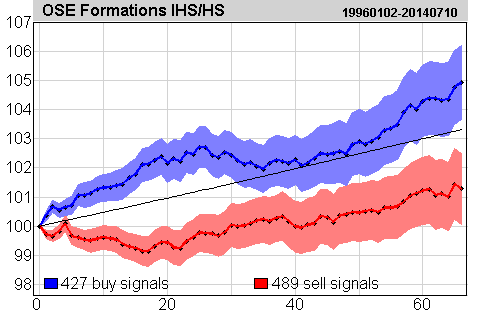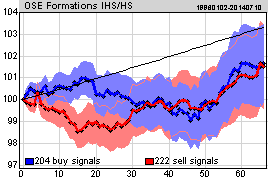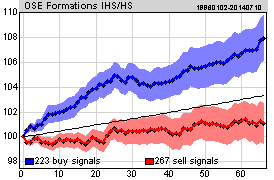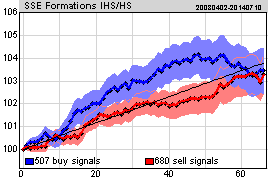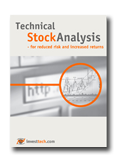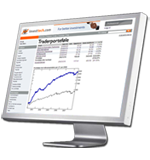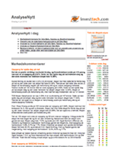Return following signals from medium long term head and shoulders formations on the Oslo Stock Exchange 1996 - 2014
Research results from Investtech, 30 January 2017
Published in English on 17 March 2017. Norwegian original here >>
About the author
Geir Linløkken is the Head of Analysis and Research at Investtech, and is responsible for portfolios and money management. He founded Investtech in 1997, to provide independent technical analyses based on science and investor psychology. Mr. Linløkken has an MSc. in Computer Science, specializing in Mathematical Modeling, at the University of Oslo. He is the author of the book “Technical Stock Analysis”. His daily work includes analysing stocks and developing quantitative methods for stock market investments.
Keywords: head and shoulders formation, inverse head and shoulders formation, buy signal, sell signal, Oslo stock exchange, statistics, technical analysis.
Abstract:
Geometric price patterns, like head and shoulders formations, are used in technical analysis to predict future price development. Many investors use this as an important part of their decision making process when buying or selling stocks. We have looked at the price movements that followed sell signals from medium long term head and shoulders formations and buy signals from medium long term inverse head and shoulders formations on the Oslo Stock Exchange in a period of 19 years, from 1996 to 2014. The results indicate that inverse/ head and shoulders formations in medium long term charts have low predictive power, even though they have shown good predictive power in long term charts and are theoretically considered some of the strongest signals of technical analysis.
Research into technical price formations
This research report is part of a bigger research project conducted by Investtech into price development following technical formations in stock prices. This report studies medium long term inverse/ head and shoulders formations on the Oslo Stock Exchange in Norway.
| Short term | Medium term | Long term | |
| Rectangle | Report | Report | Report |
| Inverse/ head and shoulders | Report | Present | Report |
| Double top, double bottom | Report | Report | Report |
Head and shoulders formations
Identification of geometric price patterns in stock prices is an important area of technical analysis. The idea is that these patterns describe the investors’ mental state, i.e. whether they will want to sell or buy stocks in the time ahead, and they thereby indicate the future direction of the stock price. Head and shoulders formations are one type of such patterns.
A head and shoulders formation is a top formation which marks the end of a rising period. The formation consists of a left shoulder, a head and a right shoulder, connected by a neckline, see figure 1. The creation of a head and shoulders formation indicates increasing pessimism among investors and the start of a falling trend. Such formations are considered among the most reliable signals in technical analysis. They are primarily used to predict reversals in long term market trends, but can also be used in the shorter term.
This formation also exists in the opposite direction, as an inverse head and shoulders formation, see figure 2. This is a bottom formation which marks the end of a falling period. An inverse head and shoulders formation signals increasing optimism among investors and the start of a rising trend.
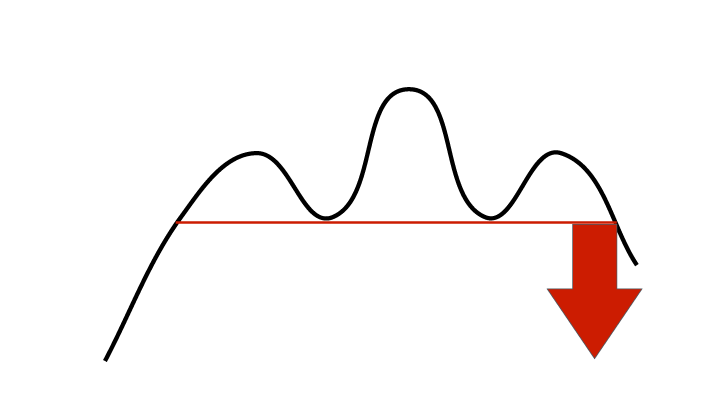
Figure 1: Sell signal from head and shoulders formation.
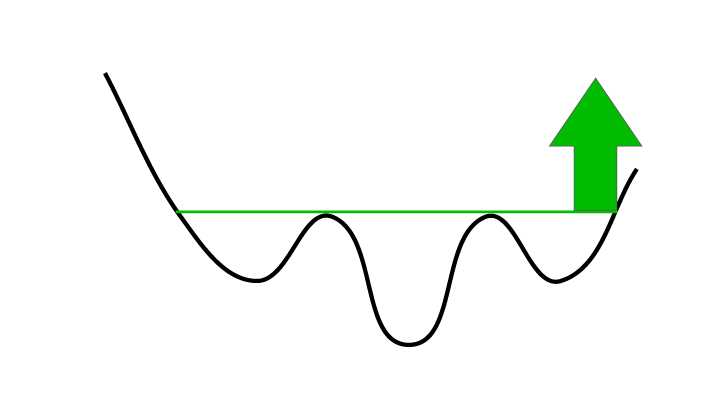
Figure 2: Buy signal from inverse head and shoulders formation.
In technical analysis terminology we say that a break downwards through the neckline of a head and shoulders formation triggers a sell signal. Similarly a break up from an inverse head and shoulders formation triggers a buy signal. We have studied the price movements following buy and sell signals from such formations on the Oslo Stock Exchange in Norway.
Identification
It is no easy task to identify head and shoulders formations in stock prices. The figures above show that the price forms a left shoulder, a head and a right shoulder, before the neckline is broken. However, stock prices are rarely as regular as these illustrations. The shoulders will often be of different sizes, the head and one shoulder may be almost the same size, or the neckline may be crooked.
Many investors identify price patterns by looking at price charts and drawing lines by hand. This method has many weaknesses, most of all that it is subjective, allowing you to see the formations you want to see, and it is very time consuming. Therefore we need an automatic algorithm whereby computers identify the formations and the signals they trigger.
Investtech has studied technical and quantitative analysis since 1997. We have developed mathematical algorithms for automatic identification of head and shoulders formations in stock prices. The formations are entered into the technical analysis charts, shows in signal lists and presented updated daily to Investtech’s subscribers.
In this report we have looked at the price movements that follow buy and sell signals from head and shoulders formations on the Oslo Stock Exchange. The statistics are based on formations automatically recognized by Investtech’s computer programs. No parameter optimization or changes to algorithms have been made during this study. This is an analysis based on the existing historical material.
The Base Data
We have used stock prices from 1 January 1996 to 10 October 2014 as the basis for the statistics. In this period, the main index on the Oslo Exchange rose from 106.9 to 573.6 points, which is 437 % or approximately 9.3 % a year. Compared to the risk free interest rate in this period, this is approximately what can be expected for similar periods of time.
In eight of these 19 years, the exchange rose by over 30 %, while it fell by more than 10 % in five of the years, and varied between minus 10 % to plus 30 % in five of the years. We have had both good and bad periods, and several sideways periods as well, and consider this representative for a normal period of time on the exchange.
All stocks that have been listed in the period are included. Stocks that have been delisted due to for instance mergers, takeovers and bankruptcy are included. However, we only have data for these companies for as long as they were listed. A company which went bankrupt will then have a final trading price which is not zero, which is a weakness in this study. However, this is only the case for a small number of companies. Most companies also fall a lot before they are delisted, so the difference between the price fall from when they were listed and a price fall down to zero will be small.
It is also very rare that new buy signals are generated from head and shoulders formations when a company’s stock price is falling. Therefore it matters very little to the statistics for buy signals. Return from sell signals would however have been a little weaker had we corrected for bankruptcies. Combined it is our opinion that these conditions have minimal impact on the results of this study.
All prices are adjusted for splits, dividend payments, reverse splits, and other corporate capital changes, in order to reflect the actual value development of the stocks.
715 time series are included, of which 597 are stocks with at least 66 days of trading. At the end of the period, approximately 220 stocks were listed on the exchange.
The stock’s daily closing price is used. We have only used prices and turnover figures from the stock’s primary market place. Alternative markets like Chi-X, Bats and Burgundy are excluded.
The Data Set
We have used Investtech’s algorithms for automatic identification of price formations. The algorithms were run on medium term charts made up of 395 price days, approximately 18 calendar months. We consider the algorithms good at identifying actual inverse/ head and shoulders formations, and they do not classify indistinct patterns as actual formations.
At identification of signals, only data up to the date the signal was triggered were used. The later data were hidden from the algorithm.
All signals identified from head and shoulders and inverse head and shoulders formations are used. Normally each formation only triggers one signal. However, in rare cases they may trigger several signals. This happens if the price following the break reacts back into the formation, creates a modified formation and then breaks out again.
Sometimes one stock can also trigger several signals on the same day. This happens if the algorithms have recognized several formations of different length and height which are broken out from at the same time.
In order to have the data set as representative for the Oslo Stock Exchange as possible, we remove certain signals from the data set:
- Duplicate signals are removed. This will be the case when there have been mergers and ticker changes, where Investtech has two editions of the same historical time series. For instance, we remove a buy signal from DNB if we already have it for DNBNOR.
- Signals that are very close in time to a previous signal are removed. It is a requirement that there have been at least seven calendar days since the previous signal from the same stock in order for a new signal to be counted.
- Formations that are less than 2 % in height are discarded. These are small and considered to have low signal value.
- Signals from stocks with poor liquidity are discarded. This is because it is difficult for investors to make actual trades in such stocks, and also because the price is often uneven and with big leaps, making pricing uncertain and subject to noise.
We discard signals where daily average turnover on the Oslo Exchange in the past ten days including the signal day was lower than half a million Norwegian krone (NOK) or where the stock was traded on less than half the days. This also removed all signals from the exchange indices, leaving us with signals from stocks and equity certificates only, and a few traded funds. The actual turnover of stocks that gave signals may have been above this limit, as trade in other markets than the Oslo Exchange, like Chi-X, Bats and Burgundy, are not included. - Signals with less than 66 days' price history following the signals are removed. This gives complete price history for the first 66 days following the signals.
Our data set now consists of 427 identified buy signals from medium long term inverse head and shoulders formations and 489 sell signals from medium long term head and shoulders formations in stocks and equity certificates on the Oslo Stock Exchange in the period 1996 to 2014.
Results
Figure 3: Price development after buy and sell signals from inverse/ head and shoulders formations on the Oslo Stock Exchange identified by Investtech’s automatic algorithms in medium long term price charts. Click the image for bigger version.
The chart shows average price development following buy and sell signals from inverse/ head and shoulders formations. The signals are triggered on day 0. Only days when the exchange is open are included, so 66 days equal approximately three months. Buy signals are the blue line and sell signals are the red one. The shaded areas are the standard deviation of the calculations. Benchmark index is the black line.
| Buy signal | Day 1 | 10 | 22 | 66 |
| Absolute | 0.37 % | 1.32 % | 2.24 % | 4.93 % |
| Benchmark index | 0.05 % | 0.48 % | 1.06 % | 3.31 % |
| Relative, percentage points | 0.32 | 0.84 | 1.17 | 1.62 |
| Statistical T-value | 1.86 | 1.82 | 1.69 | 1.26 |
| Sell signal | Day 1 | 10 | 22 | 66 |
| Absolute | -0.29 % | -0.38 % | -0.76 % | 1.28 % |
| Benchmark index | 0.05 % | 0.48 % | 1.06 % | 3.31 % |
| Relative, percentage points | -0.34 | -0.86 | -1.82 | -2.04 |
| Statistical T-value | -2.40 | -2.04 | -3.04 | -1.66 |
We have studied statistical price development following buy signals from inverse head and shoulders formations and sell signals from head and shoulders formations identified in Investtech's medium long term technical charts.
Figure 3 shows that stocks with buy signals from inverse head and shoulders formations have done slightly better than average benchmark development. Stocks with sell signals from head and shoulders formations have underperformed compared to benchmark.
The shaded areas show one standard deviation for the average estimates. The shaded areas are quite wide, which means that the uncertainty of the estimates is high. The distance between average signal development and benchmark is between one and three standard deviations, which equals statistical T-values of 1.26 to 3.04.
The results indicate some connection between signals and future price development. Particularly in the short term, approximately for the first month, there seems to be a connection. The results are less clear in the longer term, and the statistics give no reason to conclude any significant connection between signal and future price development.
The importance of liquidity
In the calculations above we have included signals from stocks with an average daily turnover of at least half a million Norwegian krone on the Oslo Stock Exchange at the time the signal was triggered. Varying the liquidity parameters allows us to investigate if there is a difference in signal strength for smaller and bigger companies.
Drawing the line at five million krone splits the companies into two roughly similar groups. Signals from stocks with turnover below five million come to 426 signals, and those with turnover above five million come to 490 signals.
Figures 4 and 5 show that signals from the group of bigger companies have done better than signals from the smaller companies. Particularly buy signals from smaller companies have weak predictive power, and the relative figures show the opposite result of what the signal should in fact indicate.
Splitting the data set means the results are based on a small number of observations. This means that the variance of the estimators, illustrated by the shaded areas, is great. Thus the results for the more liquid companies are also not considered very significant.
The Stockhom Stock Exchange in Sweden
Figure 6. Price development following medium long term buy and sell signals from inverse/ head and shoulders formations on the Stockholm Stock Exchange.
We have conducted the same study on the Stockholm Stock Exchange in Sweden, for the period 1 April 2003 to 10 October 2014. Investtech’s computers identified 507 buy signals and 680 sell signals in this period.
The results from the Stockholm Stock Exchange indicate low or no signal power for both sell and buy signals.
Read more about the Stockholm Stock Exchange study here.
Summary and discussion
We have studied return from stocks on the Oslo Stock Exchange with breaks through technical head and shoulders formations and inverse head and shoulders formations in the medium long term over a period of 19 years, from 1996 to 2014. Investtech’s automatic algorithms identified a total of 427 buy signals and 489 sell signals from such formations on the Oslo Stock Exchange. Including results from the Stockholm Stock Exchange gives a total of 934 buy signals and 1169 sell signals.
The results from the Oslo Stock Exchange indicate some connection between signals and future price development. Particularly in the short term, approximately for the first month, there seems to be a connection. The results are less clear in the longer term, and the statistics give no reason to conclude any significant connection between signal and future price development. The results from the Stockholm Stock Exchange show little connection between signals and future price development.
We have previously shown strong results from inverse/ head and shoulders formations in long term charts. These current results indicate that the connection is weaker in shorter term charts. The combined results from Stockholm and Oslo indicate that inverse/ head and shoulders formations in Investtech's medium long term charts have low predictive power. This suggests that established technical analysis theory should be reconsidered. The time perspective of the charts where the signals have been identified may be an important parameter for the reliability and significance of these signals.
Even with 11 years of data from the Stockholm Stock Exchange and 19 years from Oslo, we do not have a large data set. The results have low significance. Consequently we cannot decisively conclude that inverse/ head and shoulders formations do not have any predictive power in medium long term charts, and we would like to conduct more studies on data from several Stock Exchanges and for longer periods of time.
For now, we assume that it is statistically risky to follow signals from inverse/ head and shoulders formations in medium long term charts. These results imply that in the presence of such formations it will be useful to look at other indicators as well, for example volume balance, momentum and trend, which have all shown more significant results.
Literature
- Investtech, Insight & Skills. Price formations. Link
- Investtech, Insight & Skills. Buy signal from inverse head and shoulders formation. Link
- Investtech, Insight & Skills. Sell signal from head and shoulders formation. Link
- Geir Linløkken. Return following signals from rectangle formations – the Oslo Stock Exchange 1996-2014. Investtech.com, 2014. Link
- Geir Linløkken. Return following signals from rectangle formations – the Stockholm Stock Exchange 2003-2014. Investtech.com, 2014. Link
- Geir Linløkken og Steffen Frölich. Technical StockAnalysis - for reduced risks and increased returns. Investtech.com, 2001.
- John J. Murphy. Technical Analysis of the Financial Markets. New York Institute of Finance, 1999.
Geschreven door

Hoofd research en analyse
in Investtech
"Investtech analyseert de psychologie in de markt en geeft u iedere dag concrete trading-voorstellen."

Partner & Senior Advisor - Investtech
Investeringsaanbevelingen worden gedaan door Investtech.com AS ("Investtech"). Investtech garandeert geen volledigheid of juistheid van de analyses. Eventuele fouten in de aanbevelingen, koop- en verkoopsignalen en mogelijke negatieve gevolgen hiervan zijn geheel het risico van de belegger. Investtech neemt geen enkele verantwoordelijkheid voor verlies, direct of indirect, als gevolg van het gebruik van Investtechs analyses. Meer informatie omtrent Investtechs analyses kunt u vinden op disclaimer.
Investeringsaanbevelingen worden gedaan door Investtech.com AS ("Investtech"). Investtech garandeert geen volledigheid of juistheid van de analyses. Eventuele fouten in de aanbevelingen, koop- en verkoopsignalen en mogelijke negatieve gevolgen hiervan zijn geheel het risico van de belegger. Investtech neemt geen enkele verantwoordelijkheid voor verlies, direct of indirect, als gevolg van het gebruik van Investtechs analyses. Meer informatie omtrent Investtechs analyses kunt u vinden op disclaimer.


 Oslo Børs
Oslo Børs Stockholmsbörsen
Stockholmsbörsen Københavns Fondsbørs
Københavns Fondsbørs Helsingin pörssi
Helsingin pörssi World Indices
World Indices US Stocks
US Stocks Toronto Stock Exchange
Toronto Stock Exchange London Stock Exchange
London Stock Exchange Euronext Amsterdam
Euronext Amsterdam Euronext Brussel
Euronext Brussel DAX
DAX CAC 40
CAC 40 Mumbai S.E.
Mumbai S.E. Commodities
Commodities Currency
Currency Cryptocurrency
Cryptocurrency Exchange Traded Funds
Exchange Traded Funds Investtech Indices
Investtech Indices